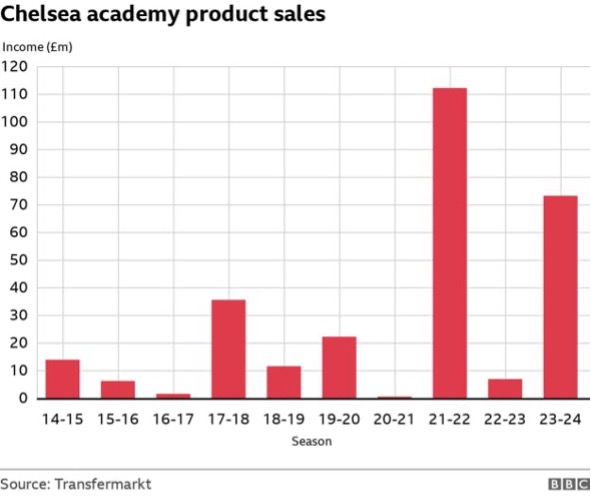The class of 92, the Ajax graduates of Cruyff, the Busby Babes.. the most successful teams of our generation have been predicated on their respective Youth academies, and cultivating an environment that fosters the development of young talent to the 1st team. This has created success and has not been anything to do with financial profit, the benefits of rearing a good youth academy have generated success on a generational footballing level.
This formula is no longer in existence; youth academies and brilliant young players are now seen to solely be a source of financial value.
Premier League weekend
If we look at the latest Premier League weekend, Palmer, Archer, Hall & Gilmour all had sterling contributions; they are all young players, and all playing for different clubs than their academies. United have recently been trying to sell Scott Mctominay, Man City sold Cole Palmer for £40 million to their rivals Chelsea. Mason Mount, Callum Hudson-Odoi, Ruben Loftus Cheek, Ethan Ampadu, all sold collectively for near £100 million. Conor Gallagher in a previous generation would likely become club captain, but Chelsea are trying to push him out the door. Why is this happening?
Well, Chelsea have been pushed to the limits due to spending near a billion pounds in the last 2 years, since Roman Abramovich left the club. FFP present real ongoing issues with regards to the financial operation at these big clubs, and the academy provides a way out.
Academy players
Academy players register as pure profit upon a transfer. FFP has historically been predicated on amortisation. This is the process of gradually writing off a transfer fee paid for a player over the lifetime of their contract. For example, if a player costs £40 million and is placed on a 4-year contract, this would cost the club £10 million for that year. However, if a player has a book value of £0, (as all academy players do because they did not cost the club a transfer fee), this permits the club to register a straight profit on a player sale. There is no loss made due to amortisation.
The problem then presents itself because players from the youth academy are then being treated as assets before their careers have commenced.

Chelsea have sold 39 players since 2014-2015 that have played for their youth academy, equating to £285 million. This is the highest earned figure in Europe.
Another benefit to clubs receiving academy players rests in the home-grown player rules of the FA. The FA rules dictate that there can only be 17 non-home-grown players in a 25 man Prem squad. To be considered homegrown, they must have played for an FA club for at least 3 years before turning 21, but do not have to be English.
This means that the demand for players such as Conor Gallagher increases, boosting the transfer fees and increasing the incentive to get rid of academy players. Aston Villa have taken advantage, selling 3 fantastic academy graduates. Cameron Archer, Aaron Ramsay and Jadon Philogene. Raising £60 million in pure profit.
What does this mean for the future of these academy prospects? It seems to be such a shame that opportunities are removed for these players to play for the clubs that raised them; they truly understand the way in which the club operates.
They are ultimately pawns in the chess game that is being played every transfer window. Their role seems to purely absolve these clubs and their boards from any potential liability from FFP. Having grown up as a Manchester United fan, the Class of 92 dream is now a shadow of the past, that fades more distant every season.